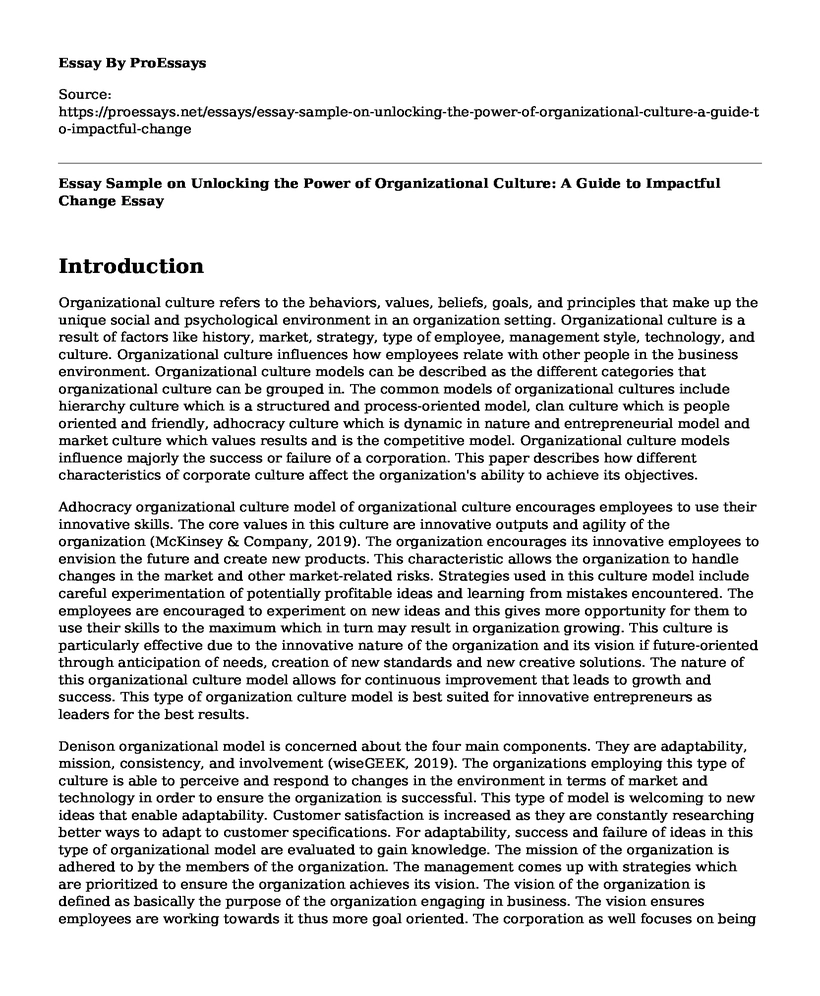Introduction
Organizational culture refers to the behaviors, values, beliefs, goals, and principles that make up the unique social and psychological environment in an organization setting. Organizational culture is a result of factors like history, market, strategy, type of employee, management style, technology, and culture. Organizational culture influences how employees relate with other people in the business environment. Organizational culture models can be described as the different categories that organizational culture can be grouped in. The common models of organizational cultures include hierarchy culture which is a structured and process-oriented model, clan culture which is people oriented and friendly, adhocracy culture which is dynamic in nature and entrepreneurial model and market culture which values results and is the competitive model. Organizational culture models influence majorly the success or failure of a corporation. This paper describes how different characteristics of corporate culture affect the organization's ability to achieve its objectives.
Adhocracy organizational culture model of organizational culture encourages employees to use their innovative skills. The core values in this culture are innovative outputs and agility of the organization (McKinsey & Company, 2019). The organization encourages its innovative employees to envision the future and create new products. This characteristic allows the organization to handle changes in the market and other market-related risks. Strategies used in this culture model include careful experimentation of potentially profitable ideas and learning from mistakes encountered. The employees are encouraged to experiment on new ideas and this gives more opportunity for them to use their skills to the maximum which in turn may result in organization growing. This culture is particularly effective due to the innovative nature of the organization and its vision if future-oriented through anticipation of needs, creation of new standards and new creative solutions. The nature of this organizational culture model allows for continuous improvement that leads to growth and success. This type of organization culture model is best suited for innovative entrepreneurs as leaders for the best results.
Denison organizational model is concerned about the four main components. They are adaptability, mission, consistency, and involvement (wiseGEEK, 2019). The organizations employing this type of culture is able to perceive and respond to changes in the environment in terms of market and technology in order to ensure the organization is successful. This type of model is welcoming to new ideas that enable adaptability. Customer satisfaction is increased as they are constantly researching better ways to adapt to customer specifications. For adaptability, success and failure of ideas in this type of organizational model are evaluated to gain knowledge. The mission of the organization is adhered to by the members of the organization. The management comes up with strategies which are prioritized to ensure the organization achieves its vision. The vision of the organization is defined as basically the purpose of the organization engaging in business. The vision ensures employees are working towards it thus more goal oriented. The corporation as well focuses on being consistent. The core values are clearly stated in order to ensure consistency in decision making and overall employee behavior. Employees are taught on the impacts of their work and the importance of coordination. Employees are encouraged to be involved in the organization. This can be through empowerment to make specific decisions, through working as teams which enhances employees supporting each other to achieve organizational goals. The employees are offered training to develop their skills and improve their overall performance in the organization.
As we have seen different corporate cultures can greatly influence the ability of an organization to achieve its objectives. Amazon seems to have adapted the Adhocracy model of organizational culture. The organization supports its employees coming up with new innovative ideas. This has influenced the new product development strategy where employees come up with new products to fill the niche in the market and in turn will result in more revenue rewards. This enables Amazon to grow with time as more products are introduced. Diversification of products comes from the diverse innovations that the employees come up with (Panmore Institute, 2019). This enables Amazon to reach different types of product market resulting in its growth. Amazon has dominated the e-market due to its early venturing into the online market. This is due to its adhocracy culture that encourages new ideas and thus they were able to successfully dominate the online market.
References
McKinsey & Company. (2019). Adhocracy for an agile age. [online] Available at: https://www.mckinsey.com/business-functions/organization/our-insights/adhocracy-for-an-agile-age [Accessed 1 May 2019].
Panmore Institute. (2019). Amazon.com Inc.'s Generic Strategy, Intensive Growth Strategies - Panmore Institute. [online] Available at: http://panmore.com/amazon-com-inc-generic-strategy-intensive-growth-strategies [Accessed 1 May 2019].
wiseGEEK. (2019). What Are the Different Organizational Culture Models?. [online] Available at: https://www.wisegeek.com/what-are-the-different-organizational-culture-models.htm [Accessed 1 May 2019].
Cite this page
Essay Sample on Unlocking the Power of Organizational Culture: A Guide to Impactful Change. (2023, Jan 10). Retrieved from https://proessays.net/essays/essay-sample-on-unlocking-the-power-of-organizational-culture-a-guide-to-impactful-change
If you are the original author of this essay and no longer wish to have it published on the ProEssays website, please click below to request its removal:
- CSR and Sustainability of the Oman Oil Company
- Strategic Positioning and Operational Effectiveness Paper Example
- Essay Sample on Churchill Synopsis
- Paper Example on Critical Path Analysis: Robust Tool for Project Planning
- Innovation and Managing Change in Apple Inc and Nokia Corporation - Essay Sample
- Essay on Strategic Audit: Progress From Specialized Perception to Overall Organization
- Paper Example on Aligning Projects, Processes and Information Requirements for Success







